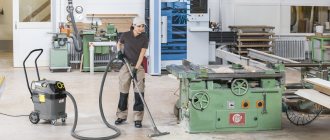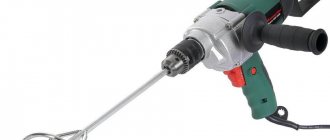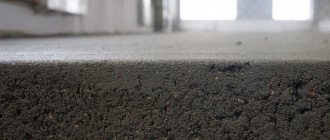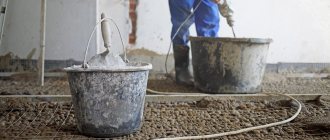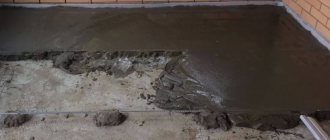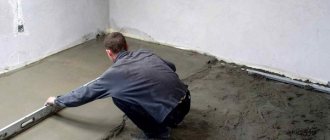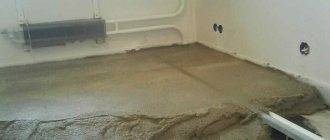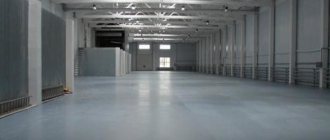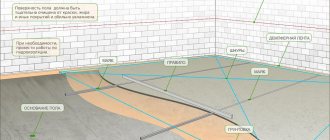Concrete floor screeds are the most common method of arranging them both in apartments and in private houses. If desired, you can install a “warm floor” system under it for greater comfort. In stores you can find many special mixtures for screeds - the article will present the best options, characterized by high quality and a reasonable price.
TOP floor screeds
What mixtures are best to use?
Construction stores offer a huge selection of self-leveling floors, so you need to immediately decide what kind of floors you want. Budget options are usually used as a base for other floor coverings. Decorative self-leveling floors will cost much more.
Floor filling mixtures
To calculate the required amount of dry mixture, you need to multiply the height of the future floor by its area. It is also necessary to carefully read the instructions for the selected mixture - it may contain information about the need for special tools or additional processing of the base.
Ironing of cement-sand and concrete screeds
When installing floor screeds, cement is used not only for preparing cement-sand mortar or concrete mixture, but also for ironing. This procedure, for which dry cement is used, allows you to strengthen the surface of the screed, reduce dust formation during operation, and increase its working life.
Stages of dry ironing:
Further work on the installation of the finishing floor covering can be carried out only 10 days after dry ironing.
Using clean dry cement for ironing is the simplest, but not the most effective option due to the fact that the resulting top crust is not very durable. Over time, this layer begins to collapse. To create a high-strength crust, it is recommended to purchase a ready-made dry mixture based on cement with various additives that improve the adhesion of the top layer to the base.
In 1998 he graduated from St. Petersburg State Polytechnic University, studied at the department of civil engineering and applied ecology.
Engaged in the development and implementation of measures to prevent the release of low-quality products.
Develops proposals for improving the production of concrete and mortars.
Source
Calculation of materials for indoor floor screed online
Before installing floor coverings, it is necessary to level all floors in the apartment or room. For floor screed, cement-sand mortar is mainly used. To save budget, it is necessary to correctly and accurately calculate the required amount of materials for the future mortar for the floor screed. The calculation can be made using an online floor screed calculator.
The values are in meters, pay attention to the thickness. Specify in this format (0.00 meters). An example of calculating the amount of required materials
An example of calculating the amount of required materials.
To calculate the required volume of solution, we use the formula:
Where,
- S – area of the room;
- H – height of the required screed layer;
- V is the required volume of solution.
Using the above formula, we can calculate the required dry volume of the mixture. An important point in calculating the required volume of solution remains the fact that the volume of a solution of cement, sand and water is less than the total volume of all ingredients. So from one kilogram of cement-sand mixture, after adding water, 0.7 kg is obtained. solution. Thus we obtain the formula for the volume of the required solution:
Volume of dry mixture / 0.7 = Volume of required solution
Cement and sand are sold in bags with payment per kilogram, so we need to calculate the quantity of ingredients in kilograms.
Based on the fact that:
- one cubic meter of cement-sand mixture weighs 1540 kg
- a cube of cement contains 1300 kg of substance
- in a cube of sand – 1625 kg
- The ratio of cement to sand in the solution is 1 to 3
- You can create generalized formulas for individual ingredients.
Where,
- M c – mass of required cement;
- M p – mass of required sand;
- S – surface area;
- h – layer height.
Bottom line. By using an online floor screed calculator in practice, you can avoid additional expenses and find out the amount of material.
Table of volumetric proportions for various grades of concrete
| Concrete, brand | Cement/sand/crushed stone ratio | |
| cement M 400 | cement M 500 | |
| 100 | 1,0 : 4,0 : 6,0 | 1,0 : 5,2 : 7,0 |
| 150 | 1,0 : 3,1 : 5,0 | 1,0 : 4,0 : 5,8 |
| 200 | 1,0 : 2,4 : 4,1 | 1,0 : 3,1 : 4,8 |
| 250 | 1,0 : 1,8 : 3,3 | 1,0 : 2,4 : 3,9 |
| 300 | 1,0 :1,6 : 3,2 | 1,0 : 2,1 : 3,6 |
| 400 | 1,0 : 1,1 : 2,5 | 1,0 : 1,4 : 2,7 |
| 450 | 1,0 : 1,0 : 2,1 | 1,0 : 1,2 : 2,4 |
| Cement brand | Brand of solution | Cement consumption rate for making 1 m3 of mortar |
| M400 | M200 | 490 kg |
| M500 | M200 | 410 kg |
| M400 | M150 | 400 kg |
| M500 | M150 | 330 kg |
Table of the ratio of concrete grade to the amount of cement, sand, gravel
Table of ratio of concrete grade to quantity
How to choose products that are high quality, durable and more
High demand for cement has led to the emergence of unscrupulous companies offering products of low quality or that do not meet standards and requirements. To buy a quality product, you need to pay attention to the following nuances:
- it is recommended to choose cement in bags ; the packaging should contain information about the composition, production date, product characteristics and manufacturer;
- to check the expiration date when purchasing ; after 6 months from the production date, the activity of the product begins to decline;
- cement must be stored in dry and ventilated areas, otherwise it will harden;
- high-quality cement should crumble in your hands and not stick together into a lump when squeezed;
- The color of good cement is grey, from light to dark grey.
Floor screed mortar - strength characteristics
Serious points depend on the strength of the cement base:
- duration of use of the foundation;
- maximum level of perceived loads.
The following methods are used for this:
- non-destructive. Control is carried out using an ultrasonic device while maintaining the presentation of the cement surface;
- destructive. The test is carried out in laboratory conditions by compressing a cubic control sample in a press.
The standard regulates the following strength indicators of cement-sand monolith:
- not less than 10 MPa – for interfloor ceilings;
- above 20 MPa – for self-leveling bases;
- not lower than 25 MPa – for thermally insulated and heated bases.
Mixing the mortar for floor screeding can be done using a drill with a special attachment
The strength characteristics of the foundation are influenced by the following factors:
- brand of Portland cement used;
- applied proportions for screed solution;
- type and size of aggregate;
- degree of compaction of liquid material;
- temperature conditions for freezing;
- moisture concentration in the working mixture;
- presence of modifying additives.
Types of cement screeds
There are many options for making floors made of cement-sand mortar. The proportions of the components can be different, you can add various additives and plasticizers, choose a polymer-cement screed and make floors with a 3D effect, etc. But there are two main types of screed arrangement: tied and untied screeds, as well as floating.
A bonded type cement screed is installed when pouring a layer of up to 4 centimeters. In this case, the base becomes a single monolith with walls and floor. The rough foundation needs to be prepared - cracks must be sealed, large holes, bumps and pits must be eliminated. Small defects with a difference of up to 3 centimeters can be left.
Before making a cement-bonded floor screed, it is advisable to go over the base with a wire brush to improve adhesion. The filling composition should resemble sour cream in consistency and hardens within 20 minutes after installation. Large premises are filled in stages. The screed takes up to 40 days to dry, maintaining the temperature and humidity conditions under the film.
An untied screed must be mounted on an already ideal surface. The base should not absorb moisture. The layer when installing this type of screed can be 5 centimeters or more. Before pouring, no primer is used, nor are methods for increasing adhesion.
A floating screed is installed when you need to make a layer of 5-8 centimeters. Cementing does not involve contact of the screed with the subfloor, since heat/waterproofing and different materials are installed between the layers. Typically, reinforcing mesh is used; fiber fiber is added to the solution, which increases the strength of the layer and eliminates the risk of crack propagation.
A floating (including reinforced) screed does not involve too much weight, since, despite its considerable thickness, it is poured using a semi-dry technology: the solution is mixed with a reduced volume of water, so it resembles wet sand in structure more than a liquid mixture.
Number of PCB bags for brickwork and calculations on a calculator
Laying a brick wall should be done using a mixture with a grade corresponding to the brick. This structure is as durable and uniform as possible. In general, M100-M200 is used for masonry.
So it is necessary to take into account the quality and strength of the material (both the mixture and the brick). Using basic standards, approximately 250 kg of M100 mixture should be used per 1 m3 of wall.
The use of sand is a necessary measure when carrying out any construction or repair work. Here everything is about quartz sand.
If you prepare the solution yourself, then the proportion should be 1 to 4. Liquid should be added to the CPS, which is usually half the total weight of the mixture.
Of course, the laying of a wall greatly depends on the thickness of the seams; as the space between the bricks expands, the amount of mortar per 1 m3 also increases. The thickness of the walls also plays an important role, so for facing bricks laid in 1 layer, significantly less cement is required than for load-bearing walls of 2-4 bricks.
Regulatory documents contain detailed recommendations and the relationship between wall thickness and the amount of mortar used.
Examples are presented based on ordinary bricks and the required quantity per 1 m3:
- wall 12cm - 420 bricks and 0.19 m3 of mortar;
- wall 25cm – 400 bricks and 0.22 m3 of mortar;
- wall 38cm – 395 bricks and 0.234 m3 of mortar;
- wall 51cm – 394 bricks and 0.24 m3 of mortar;
- wall 64cm - 392 bricks and 0.245 m3 of mortar.
Proportions of cement and sand for floor screed:
The basis of the concrete mixture is cement, therefore, when constructing the base, great attention should be paid to its grade, since the quality and durability of the finished floor laid on this base will depend on this. To make floor screed mortar, you should use Portland cement marked at least M300, and best of all M500
To make floor screed mortar, you should use Portland cement marked at least M300, and best of all M500.
It is better to use quartz crystalline sand, carefully sifted, the homogeneity and plasticity of the solution will depend on this. Rounded river sand creates less adhesion in the finished mortar, so the top layer of the screed wears out and collapses faster.
We have already talked about the advantages and disadvantages of dry and semi-dry floor screed in the article - dry and semi-dry floor screed - the pros and cons of both types, if you are interested, be sure to study them.
If you have high-grade cement and high-quality sand, experts recommend preparing the mixture in the proportion: 1 part cement to 3 parts sand, and in this case water will be needed in approximately two parts to one part cement. Many people increase the presence of cement by making mixtures of 1:2, and sometimes 1:1, trying to increase the strength of the resulting base. Such changes in composition make the solution “hard”, it sets faster and therefore it is almost impossible to make an even base with it, verified according to the “beacons”.
Today on the building materials market you can purchase ready-made mixtures for any type of work, but their markings indicate only the strength of the solution, so it is necessary to carefully select the appropriate ready-made mixture
When choosing, you should pay attention to the brand of cement, as well as the proportions of cement and sand for floor screed in the proposed mixture. But it’s cheaper and much more reliable to prepare the solution for pouring the base yourself, using construction technologies that have long been proven by specialists
Dry mixes
Do-it-yourself cement floor screed can be done using ready-made dry mixtures. Their main advantage is the absence of the need to calculate the proportions of the components included in the composition and, as a result, stability of characteristics and excellent results. The manufacturer prepares the mixture, the foreman’s task is to calculate the required volume of the mixture to complete the work and mix the solution on site, adding water.
Dry building mixtures are also distinguished by their ease of preparation, density, plasticity - they are comfortable to work with, they often demonstrate improved characteristics due to the introduction of various additives, plasticizers, etc. into the composition. All you need is to look at the mixture consumption in the instructions, purchase the required number of bags (25-50 kilograms each), add water according to the instructions and work.
Mixtures for screeding using dry and semi-dry technology are available on the market. Thus, the polycement mixture is more convenient to work with due to its elasticity; it is often used in industrial and civil construction to create new structures and restore existing ones.
Self-leveling mixtures for floor screed are very popular - you just need to pour this solution onto the surface, it will distribute itself evenly and perfectly evenly. True, it does not guarantee high strength and is inferior to dry mixtures reinforced with metal fiber fiber. The self-leveling mixture option is ideal for residential premises where the load on the floor is light. Lightweight concrete mixtures are also used here.
The modern market offers a large selection of dry mixtures of domestic and foreign production. The range is very wide and choosing an option even for fairly specific requirements is not difficult. While cement for floor screed one way or another assumes certain properties and parameters, ready-made mixtures can give very different effects due to the introduction of various components into their composition.
An example of such a product would be the Knauf Ubo mixture from one of the best manufacturers in the segment (German company Knauf). This is an ideal option for preparing CSP, which has a density that is 4-5 times greater than that of classic concrete. The screed is resistant to any temperature changes and is perfect for installing underfloor heating systems. Provides good sound insulation due to the introduction of polyethylene modifiers into the composition.
To fill one square meter you need about 5 kilograms of the mixture. And this choice is justified for pouring in a residential area due to the ease and simplicity of installation and the excellent performance characteristics of the floor.
Screed mortar - how to calculate the consumption and amount of cement on a calculator
There is no standard formula that would calculate the exact volume of cement material required for a screed.
So, for example, to use the M400 or M500 brand, the required proportions for floor screed in a residential building are 1:3.
The required value of cement consumption is calculated from the product:
- room length;
- thickness of the screed layer;
- area of the room.
To the obtained value it is necessary to add about a quarter of the calculated amount of materials. Because the finished cement mortar gives sediment. If you decide to use ready-made mixtures, then the approximate consumption volume will be 17-20 kg per 1 m2, taking into account that the permissible thickness of the screed will be 1 cm.
What will be the consumption of mortar per 1 m2 of screed with a thickness of 30 mm? For example, let’s take a room area of 12 m2. The grade of cement used is M400. Now let’s calculate the volume consumption of the finished solution:
12 * 0.03 = 0.36 m3,
Let's calculate what the cement consumption will be for a given area. According to the standards, 410 kg of cement of a specific brand is used per 1 m3:
410 * 0.36 = 147.6 kg. Or 3 bags of standard packaging of 50 kg.
We also calculate the required amount of sand and water for the solution:
We take the proportions 1:3, which means you will need 9 bags of sand, with the same weight. For every kilogram of solution, 0.2-0.5 liters of water is required, which means that for the entire volume of the solution you will need:
147.6 * 0.2 = 73.8 liters.
The dry solution should be mixed thoroughly before adding water. It should also be mixed immediately before applying to the floor. In this case, a trowel and shovel are used.
It should be taken into account that 1 liter of ready-made solution requires approximately 1.5 kg of cement. This means that from one bag you will get only 36 liters of the finished mixture. That is why another 25% of dry material is added to the final calculated figures.
If you want to further strengthen the screed, add PVA glue to the solution; it will act as a plasticizer.
For more information on how to prepare a screed solution, watch the video:
GOST 31108-2003
GOST 31108-2003 “General construction cements”:
- CEM I - Portland cement;
- CEM II - Portland cement with mineral additives;
- CEM III - Portland slag cement;
- CEM IV - pozzolanic cement;
- CEM V is a composite cement.
For the construction of a mechanized screed, Portland cement is used - a high-quality product obtained by finely grinding clinker and gypsum. The optimal solution would be PC M400 or PC M500. Marked “D0” - where there are no mineral additives.
Breeding rules
Installation of cement-sand screed
How to dilute cement for large volumes of finishing is of interest to any owner. To do this, use a concrete mixer, and for small ones, a construction mixer or a special attachment for a drill.
The process of mixing the mortar occurs as follows: first, dry components are placed in a container and mixed until the composition is homogeneous, then the required amount of water is poured. The water in the composition is equal to an average of 0.8 units of the amount of cement. Mix the components at low speed for 5-10 minutes until there are no lumps left.
It is important to remember that you can only work with the resulting mass for a maximum of 1.5 hours, otherwise it will harden. When using human labor for kneading, you should calculate the volume of the trough for 10–20 buckets
It is convenient to mix after adding every two buckets of sand. This speeds up the process and leaves no lumps
When using human labor for kneading, you should calculate the volume of the trough for 10–20 buckets. It is convenient to mix after adding every two buckets of sand. This speeds up the process and leaves no lumps.
Preparation and use of lime-cement mortar
Liquid soap or dishwashing liquid (for example, Fairy) is often added to standard solutions for plasticity. Its volume per concrete mixer should be no more than 100 grams. This material is more pliable and dries slower.
Particular attention should be paid to the quality of the sand. When laying or plastering, use only sifted, washed sand without pebbles.
Its moisture content during kneading will affect the amount of water added. Only if the sand is dry should you add all the water according to the recipe. If the sand is wet, you need to add water gradually, checking the consistency.
Additives: necessary or not?
It may be recommended to add plasticizers and fiberglass or other substances for micro-reinforcement to a classic floor screed solution. Are they needed or not? First you need to understand what it is and why.
When making a screed mortar, you can get by with only sand and cement
Plasticizing additives
Plasticizers are substances that increase the plasticity of DSP. It is easier to work with such solutions. Concrete with a plasticizer adheres better, is easier to level, and gives a smoother surface. In general, if all the components are of normal quality and well mixed, then it is not difficult to work with them when mixed with water. With additives, of course, it’s easier. But factory plasticizers cost a lot of money, and this increases the cost of the screed. They need to be added in small quantities, but when pouring the floor in a house, the cost is per cubic meter, so the costs will be noticeable.
When mixing, the proportions of the solution must be observed with great precision. To make the solution fit better, add plasticizers rather than more water
As usual, craftsmen have found a replacement for factory plasticizers. Add regular soap to the solution. Its consumption is very small - a glass or so for one concrete mixer. The plasticity of the solution increases, so many people use this type of additive. For beginners, it is worth saying: do not exceed the recommended dose. The solution will not get better, but it may well get worse. Soap increases plasticity by “lubricating” the sand, reducing its “adhesion” to the cement slurry. Exceeding the dosage may lead to a decrease in the strength of the screed. So be specific.
Micro-reinforcement
As you know, when drying, cement-sand mortar shrinks. The amount of shrinkage is from 1.5% to 3% of the volume. The exact percentage of shrinkage depends on the amount of foreign impurities (if the sand is washed, the shrinkage will be less), the correctly selected composition of the filler (in this case, sand), precisely observed proportions and a number of other conditions and factors.
This is what polypropylene fiber fiber looks like
Everything would be fine, but when shrinkage occurs, cracks form in the solution. They are always there, only larger or smaller in size, in larger or smaller quantities. To reduce the number of cracks, micro-reinforcement materials are added to the solution. Fiber fiber is most often used in everyday life. It happens:
The most popular fiber for household purposes is polypropylene fiber. It is the most inexpensive and gives good results. How does it work? 100 grams of this supplement contains a huge amount of synthetic fibers. They are very thin, but synthetics are highly durable. These fibers are randomly but evenly distributed throughout the entire thickness of the solution. In concrete, they form a kind of lattice in space. When stresses arise when the screed dries, they bind the parts of the mortar together, reducing the number and size of cracks.
It is important to comply with supplement standards
The second effect of fiberglass is a smoother and more durable surface. So this additive to the floor screed solution is more useful and is definitely worth using. But again, strictly according to the recommendations. It seems that if you add more fiber, there will be fewer cracks, but no. The strength of the screed will decrease.
Consumption rates for different solutions
Depending on what concrete is needed for, 1 m3 of solution may contain different volumes of cement. In modern construction, concrete mortar is used to carry out four tasks: pouring the foundation, laying building blocks, pouring screed and performing plaster. For each of these types of work, it is assumed that a certain type of mortar with a specified volume of cement will be prepared.
The highest consumption of cement per cube of mortar is obtained when preparing a mixture for masonry or plaster. When pouring a foundation or screed, it is important to use large fillers (gravel, crushed stone, slag), which reduces cement consumption. The purpose of the solution is indicated by the brand (the properties of concrete and the main characteristics depend on it).
Calculation of cement per cube of concrete according to GOST:
- M100 – 170 kilograms of cement
- M150 – 200 kilograms
- M200 – 240 kilograms
- M250 – 300 kilograms
- M300 – 350 kilograms
- M400 – 400 kilograms
- M500 – 450 kilograms
For plaster
A standard plaster solution is prepared from 3 parts sand and 1 part cement. If the layer is made with a thickness of no more than 12 millimeters, then 1.6 kilograms of M400 cement and 1.4 kilograms of M500 cement are weighed per 1 square meter of plaster. The volume of mortar per cubic meter of masonry can be calculated as follows: 1 m2 x 0.012 m = 0.012 m2 = 12 liters.
On masonry
For a square meter of brickwork one brick thick, you will need at least 75 liters of M100 mortar. The proportion of M400 cement and sand is 1:4. Thus, the cement consumption for bricklaying is 250 kilograms per cubic meter of sand. How many cubic meters of solution will be needed in total is calculated based on the size of the building.
Water is taken in a volume equal to half the weight of cement. So, if you mix the solution using buckets, it turns out like this: 1 bucket of M500 cement, 4 buckets of sand, 7 liters of water.
For the foundation
To prepare a solution for pouring the foundation, you need to calculate everything correctly. Typically, a solution of grade M100-M300 is used. The strength of M100 is sufficient for low-rise buildings, M150 and M200 are suitable for buildings of several floors. The higher the grade, the stronger the structure will be. For mixing, take cement M300/M400 (1 part binder and 3 parts sand) or M500 (1 part binder and 5 sand).
Cement consumption per cubic meter of solution:
- M50 (based on M400 cement) – 380 kilograms
- M100 (based on M300 cement) – 214 kilograms
- M200 (based on M400 cement) – 286 kilograms
- M300 (based on M500 cement) – 382 kilograms
Such calculations are relevant if the mixture is prepared according to the following proportions: 1 part cement, 2-4 parts sand, 3 parts crushed stone/gravel.
For screed
The proportion for mixing is as follows: 1 part cement and 3 parts sand. Here you can give an example of correct calculations. So, you need to fill a surface of 3 by 4 square meters (12 is obtained) with a layer thickness of 30 millimeters.
Calculation steps:
- Determining the required volume of concrete solution: 12 m2 x 0.03 m = 0.36 m3.
- Choosing a brand of concrete - take M200, prepare it from M500 cement, which requires 410 kilograms.
- Calculation of the number of bags of cement: 410 kg x 0.36 m3 = 148 kg / 50 = 3 bags (almost).
- How much sand is needed: 1600 kg/m3 (weight of a cubic meter of mixture) x 0.36 m3 (required amount of mixture) = 576 x 0.75 (proportion of sand in concrete) = 432 kilograms. A cube of sand solution will take about 1200 kilograms.
Types of solutions
The calculation of the screed is done after selecting the components; for this you need to understand the types of options that are suitable for the job. One of the popular options is sand-cement. The following type properties can be distinguished:
- Heavy weight;
- High level of strength properties;
- Moisture-resistant, vapor-permeable;
- Recommended thickness 4 cm;
- Suitable for rooms with different purposes, you can introduce modifying elements.
PCB in a garage, barn, bathhouse and other ancillary buildings can be used without a finishing coating; sand can be replaced with granite screenings. A long-drying mortar, initial setting occurs after two days, but full strength is achieved after 28.
Lightweight PCB with expanded clay is a screed with insulation, expanded clay does not release heat, and its presence also helps reduce the weight of the solution. There are different types of expanded clay granules:
- Crushed stone, fraction size varies between 5 and 40 mm, intended for thick coating;
- Expanded clay gravel, there are different sizes: 5-10 mm, 10-20, 20-50. It is distinguished by its high heat-insulating properties and resistance to cold;
- Sand, fraction sizes no more than 5 mm, suitable for thin screed or pouring a layer.
Gypsum mortar is applied between the wet and dry layers of coating, or a floating version is made over the insulation layers. Peculiarities:
- Low price;
- You can cover communication parts and electrical wiring;
- Can be used between layers of insulation of different thicknesses;
- You can apply loads to the coating 12-15 hours after grinding the base.
Suitable for laying laminate, parquet, linoleum, ceramic tiles, carpet.
You don’t have to calculate the proportions of concrete for outdoor screed for a long time if you purchase ready-made mixtures. There are different options for different purposes, so choosing the right type is easy. Advantages:
- Easy to use, you only need to mix with water, the ratio of components is precisely calculated by the manufacturer;
- Variety of types;
- High level of strength properties.
The disadvantage is that the cost of the solution will be higher compared to the option of independently selecting the elements.
Filling the screed
Filling the screed
Before starting work, you need to clear the pouring area of debris and the like. Then:
- we lay waterproofing or treat the surface with a primer;
- We set up beacons. Step no more than 60 cm;
- pour the solution. We level it so that the level of the screed coincides with the level of the beacons;
- After pouring, leave the screed to dry. After a day you can already work on it, although it will gain full strength within two weeks, depending on the temperature. The higher the room temperature, the faster the solution sets;
- if you need to level the surface of the screed, fill in another layer. Just remember that each subsequent layer must be of the same strength as the previous one.
Mixture application technology
The key to successful work is careful preparation of the floor before pouring the screed. To do this, the surface is cleaned to the ground and all debris is removed. At the primary stage, the presence of cracks is checked. They need to be sealed immediately. Next is priming the floor.
The screed is applied along the beacons. To do this, determine a control point and use a level to place marks around the perimeter of the room. Then, after a certain distance, beating cords are pulled along them, remembering that the direction of laying the screed is perpendicular to the direction of the cords.
It is more convenient, of course, to work with lighthouse slats, especially if the rough work involves reinforcing the floor. After complete marking, the slats are fixed with a small amount of solution. Direct work begins 12-15 hours after surface preparation. The step between the beacons is 15 cm less than the length of the rule that will be used to level the solution.
Next they move on to laying the mixture. They work in sections. The solution is poured between the beacons until its level reaches the control mark. Start from the far corner, gradually moving towards the front door. Leveling is done using the rule of moving towards yourself. If dips are found, then add a solution to them, rather than stretching the already poured mixture over the entire area. Residues are dumped into “clean” areas. Experienced craftsmen advise leveling the screed within 1-2 mm of the beacons to avoid deformation after shrinkage.
You can walk on the flooded floor within a day. If depressions are found, they are filled with solution; if there are tubercles, they are immediately cut off. The longer the floor dries, the more difficult it is to eliminate defects.
At the final stage, the surface is grouted. But this is not the end of the work. Over the next 10 days, the screed is moistened with a spray bottle or roller. This is necessary for uniform drying of the cement so that cracks do not appear in the future. To prevent the solution from losing natural moisture, you should not create drafts in the room, trying to artificially speed up the drying process. On the contrary, a greenhouse effect is created on the screed by covering it with film.
The load is increased gradually. To do this, lay wooden slats on the floor and walk only on them. It will be possible to evaluate the quality of the work performed only after two weeks. First, check the color, which will tell you how evenly the cement has dried. Next, look for the presence of failures. To do this, take a rule and check the gaps.
The technology for pouring screed is not so much complicated as it is labor-intensive. If all the manufacturer’s recommendations and the technological process are followed, then you can screed the concrete floor yourself.
General concepts
In order not to make mistakes when pouring cement mortar, you need to clearly understand why the floor screed is needed, what functions it performs, how to prepare the cement mortar, what proportion of the ingredients used should be observed when you make the mortar.
Screed concrete is used as flooring in country houses and apartments.
The main issues that are resolved during the pouring process include:
- Leveling the floor surface.
- Strength strengthening of the array.
- Increasing heat and sound insulation parameters.
- Creating, if necessary, the required floor slope.
- Increasing the height of the cover.
- Preparation for laying utilities (warm floors).
- Uniform distribution of loads.
Rating of the best floor screeds
| Nomination | place | Name of product | price |
| Rating of the best floor screeds | 1 | Weber Vetonit 6000, 25 kg | 439 ₽ |
| 2 | Fast-hardening floor screed Bolars, 25 kg | 231 ₽ | |
| 3 | Perfekta Fiber layer, 25 kg | 195 ₽ | |
| 4 | Axton, 25 kg | 175 ₽ | |
| 5 | Thermal insulating floor screed Paladium Palafloor-307, 12 kg | 523 ₽ | |
| 6 | Sand concrete M-300 RUSEAN, 40 kg | 140 ₽ |
Surface preparation
The preparatory stage includes:
- dismantling the old coating;
- removing skirting boards and doors;
- cleaning the floor with a brush or grinding device, removing glue, concrete crumbs, pieces of the mixture;
- removal of construction and other debris, dust and dirt;
- putty of cracks and cracks.
To enhance adhesion between the layers of the screed, the old base should be moistened. Cleaning can be done with a regular vacuum cleaner, and a regular soap solution is used to degrease the surface after dismantling.
Slots and cracks are puttied with a thin and almost invisible layer. A product containing resin or adhesive solution is suitable for this purpose.
It is not recommended to work with open windows and low air temperatures, as the result will not be what is needed.
General concepts
In order not to make mistakes when pouring cement mortar, you need to clearly understand why the floor screed is needed, what functions it performs, how to prepare the cement mortar, what proportion of the ingredients used should be observed when you make the mortar.
Screed concrete is used as flooring in country houses and apartments.
The main issues that are resolved during the pouring process include:
- Leveling the floor surface.
- Strength strengthening of the array.
- Increasing heat and sound insulation parameters.
- Creating, if necessary, the required floor slope.
- Increasing the height of the cover.
- Preparation for laying utilities (warm floors).
- Uniform distribution of loads.
Why is accurate calculation of sand concrete for floor screed so important?
Sand concrete has proven itself to be a reliable and long-lasting coating. It is easy to use and gives high-quality results both for large-scale construction and minor repair work: wear resistance, moisture resistance, resistance to temperature changes. High-quality characteristics and low price have gained popularity of this material.
The most important thing when working with sand concrete is to correctly calculate the mixture consumption. If you use it too economically, the screed may turn out to be fragile; if you use a generous layer, you will get excessive thickness and overconsumption of the mixture, as a result of which it will seem far from an economical option to you.
Another factor to consider is the amount of water added to thin the mixture. If the volume of liquid is too large, it will be much easier to lay the mixture, and you won’t have to work too hard when leveling
On the other hand, an incorrect water-cement ratio will lead to a decrease in surface strength, crumbling and the formation of chips and cracks.
If there is a need to increase the volume of water in the screed, then the cement content must be proportionally increased. But since we do not know in what proportions it is added to the mixture, this will be problematic.
Excess cement in the mixture will not only increase its cost, but will also lead to stress in the screed caused by increased strength. This condition of the coating leads to the formation of cracks. So the correct calculation of the proportions of the components in the mixture is one of the important preparatory stages of the screed.
Shrinkage of concrete during hardening is an inevitable process. This is due to internal tension. Polypropylene fiber will help reduce the formation of cracks and increase the strength of the coating. The use of reinforced mesh distributes the load and prevents the occurrence of cracks at later stages, promoting the formation of a stable coating.
Scope of use
The scope of application is determined not only by the composition, but also by the grade of cement in terms of compressive strength.
The higher it is, the more reliable the structures and the longer their service life. Therefore, when choosing which cement is better: D0 or D20, you need to take into account the purpose and conditions of use of the objects. Among the most common are:
- M400 D0
It is characterized by high frost resistance, average shrinkage deformations and hardening rates. It is used for the manufacture of prefabricated and monolithic structures in private construction and the construction of industrial facilities. - M400 D20
is characterized by average shrinkage deformations, frost resistance and hardening rate. Used for the production of various concrete structures. - M500 D0
is characterized by high frost resistance and durability. Therefore, it is used in the construction of large industrial structures, bridge structures, airfield pavements and during various restoration work. - M500 D20
has average frost resistance and hardening. Serves as a raw material for casting monolithic products, in private construction and decoration.
Self-leveling floor pouring technology
The prepared mixture is gradually poured onto the concrete base, starting from the recesses (if any). The mixture is then spread with a notched trowel and leveled with a notched roller.
Leveling the mixture with a toothed roller
After pouring, the coating must be compacted, removing air from it. For this procedure, special shoes are used - “crampons”. You can use the new floor only after it has completely dried (the time is determined according to the instructions).
Common Mistakes
- The self-leveling floor is called self-leveling because the plastic mixture spreads, forming a perfectly flat surface. But sometimes the mixture needs help. When the spilled solution does not reach the corner, it is stretched there using a notched trowel.
- An incorrectly selected roller may move the mixture too intensively, or not move it at all. The needles of the “correct” roller should be 1-2 mm higher than the filling level.
- It is better to provide dampers in advance and take into account the height of the threshold, even if it seems that the threshold is high enough and is capable of containing the spilled mixture in the room. However, the slope of a room can be deceptive. In any case, the installed dampers will not interfere, but they will eliminate the need to urgently look for suitable materials to create a barrier in the path of the flowing mixture.
- Don’t save time and make a preliminary measurement of the heights of the room. There are cases when some irregularities are not visible to the eye before pouring the mixture. And after the work is completed, a protruding bump will ruin the entire repair and require additional expenses.
Despite some features and nuances, screeding a floor with a self-leveling ready-made mixture is a fairly simple and very interesting process that does not require professional skills and provides an excellent result.
Filling a self-leveling floor: preparation of the solution and pouring technology Self-leveling floor screed: mixture composition and pouring technology Self-leveling floor: necessary materials and pouring technology How to make a concrete floor in a garage: requirements and pouring technology
Features and Benefits
The weight of one square meter of cement screed 1 centimeter thick averages from 16 to 20 kilograms. Screeds using expanded clay or polystyrene weigh a maximum of 18 kilograms, self-leveling mixtures show a figure of 16 kilograms.
In cases where differences in the subfloor reach 3 centimeters or more, a cement-sand floor screed is the best option. The screed can be tied and firmly adhered to the base, or unbound (floating), when the layer is placed on an additional layer (usually a mixture of sand and expanded clay), which acts as thermal insulation and protects against moisture.
The thickness of the cement-sand screed can be different. On average, the area can support a weight of up to 300 kilograms. If you need to increase the strength and ability to withstand different loads, the screed is reinforced with steel rods or mesh. The frame is placed on top of the expanded clay layer or attached to special fasteners or sheets of plasterboard.
Sand-cement screed has a porous structure, due to which it can absorb moisture. Therefore, the layer inside the building must be insulated with a special membrane, or waterproofed with bitumen mastic.
It is quite possible to carry out all the work on arranging a floor screed with your own hands. The main thing is to do everything according to the rules and preliminary calculations. When the screed has hardened and gained full strength, it acquires a rich gray tint.
The layer should be even and dense. If cracks or chips appear on the surface, it means that the proportion of the components was violated or the pouring technology was not followed, or the rules for drying the screed were ignored.
The main advantages of cement-sand screed:
- High-quality leveling - for any type of decorative coating.
- Durability – the service life of a concrete floor is on average 50 years.
- The ability to disguise communications inside the screed - sewer, water pipes, wires, underfloor heating systems, etc.
- Strength - the screed can withstand any load from furniture, equipment, etc.
- Good sound insulation - the screed almost does not conduct sound, and if it is also accompanied by a layer of sound insulation, the effect is magnificent.
- Thermal insulation - the minimum thickness of the screed and itself retains heat well, but if necessary, you can lay a layer of thermal insulation, ensuring the best characteristics.
- Minimal shrinkage - provided that the cement for the screed has been chosen of high quality, and the mixing is done correctly with the correct proportions.
- Quite a low price when compared with alternative methods of flooring.
Among the disadvantages that sand-cement screed may have are the following: large weight (depending on the thickness of the layer) and considerable pressure on the floor, long drying time (during which no further work can be performed - and this is about a month), the difficulty of creating a perfectly flat surface with your own by hand (but you can pour a self-leveling mixture on top), a long and labor-intensive pouring process.
Carrying out preliminary calculations and a properly executed screed allows you to eliminate most of the shortcomings and achieve an excellent result in the form of a strong, durable, even floor that is ready for further finishing.
Calculation of the amount of sand concrete for screed
Let’s be clear right away: even experienced craftsmen cannot make an accurate calculation of sand concrete for a screed. This is explained as follows:
- Even accurate measurements do not take into account all the bumps and depressions on the surface. Namely, the height of the applied layer of solution depends on them. Consequently, all calculations are approximate.
- The consumption of the building mixture used is determined by the amount of water required to prepare the solution, and is determined by the master independently.
So after calculating the sand concrete for the screed, add another 10% to it and purchase the mixture or its components with this in mind. Believe me: it’s better to have a supply than to run to the store to buy additional materials while working. This is fraught not only with loss of time and costs for travel and delivery, but also will affect the quality of work. The trouble is that the solution on the already filled part of the floor will set during this time, and when a new layer is applied, the quality of adhesion between the layers may weaken. And for floors designed for high loads, this indicator can be critical.
Recommended articles on this topic:
Soundproofing the floor in an apartment: practical methods Stages of renovation in an apartment: 54 valuable tips How to choose a company for renovation and what to pay attention to
To summarize what has been said, we note that buying a ready-made solution will be cheaper than preparing it yourself. Even if you pay the same price for all the components, consider how much effort and time you will spend on delivering and mixing them. And if the calculation takes into account the risks associated with improper proportions, the formation of cracks and the prospect of alterations, then the cost of screed from a self-made mortar will increase significantly.
Below are data for an approximate calculation of sand concrete for floor screed. The calculator can also be found on the Internet, but it is not difficult to determine the proportional composition of the components when preparing the mixture yourself, using the basic values from the table:
Table. Number of parts of cement and sand for preparing concrete
| Cement brand | Brand of solution | ||||||
| 100 | 150 | 200 | 300 | ||||
| cement | sand | cement | sand | cement | sand | cement | sand |
| 300 | 1 | 3 | 1 | 1 | |||
| 400 | 1 | 3 | 1 | 1 | |||
| 500 | 1 | 3 | 1 | 2 | |||
| 600 | 1 | 4 | 1 | 3 |
Let us clarify that these calculations give tentative results, so stocking up on building components costs a little more than planned.
- Calculate the area where you plan to pour the subfloor. For this purpose, length and width are measured. The area is obtained by multiplying these indicators.
- Determine the thickness of the screed taking into account surface unevenness and maximum possible loads. Please note that a layer of sand concrete is applied five or more centimeters.
- Select the area that has the greatest plane slope and measure the deepest place on the surface. This should not be just a single hole, but the lowest point of the surface. Determine the average value between the largest and smallest thickness, multiply the resulting result by the area of the room.
- This will give you the volume of solution needed to level the floor.
When working to level the surface, these calculations will not give accurate results, since the surface may have not only unevenness, but also slopes. If you do not take this into account, then calculating the consumption of sand concrete for a screed is not difficult at all. As a rule, the pouring height is no more than 7 cm. 18 kg of mixture is required per 1 m2 of surface (this value can be from 15 to 25 kg depending on the manufacturer) for a layer of 1 cm. Therefore, the calculation of sand concrete for floor screed per 1 m2 will be as follows: 7 cm multiplied by 18 kg. The resulting 126 kg is the amount of mixture you will need.
What is concrete class
Let’s say the brand of the existing concrete floor is M 100, but certain sections of the screed always have slightly lower strength parameters (50 kg) and approximately the same amount with higher ones (150 kg). Strength from the minimum value to the maximum is distributed according to mathematical statistics corresponding to the normal distribution. If you plan the average strength of a floor screed, then in practice, in fact, half of the products will have strength parameters that are too high, and the other half will have insufficient strength parameters.
Classes and grades of concrete
When ordering a floor brand with minimum strength, the customer signals a deliberate reduction in the required indicators, which has a negative impact on the durability and operational safety of the building.
To eliminate the described problems, the ensured strength of concrete is used - the most objective and universal definition, called the class of concrete for pouring floors.
What determines the strength of precast concrete?
If we keep in mind that the distribution area is calculated by the formula, then the strength class is a cutoff point indicating the minimum values from which the area of the figure is equal to the security. If the endowment t = 0.95, then the area should be the same. 95% is the generally accepted standard for the strength of all concrete structures, regardless of their purpose. The fact is that in the calculations, various physical concepts of strength and additional safety factors are used, which completely eliminates the possibility of emergency unforeseen situations due to the low strength class of the concrete screed. We'll talk a little more about these parameters below.
Scheme of the main types of concrete macrostructure
If you set a strength class of 80 kg, then 95% of the floor area will have a strength higher than this indicator. Concrete class is a statistical concept.
